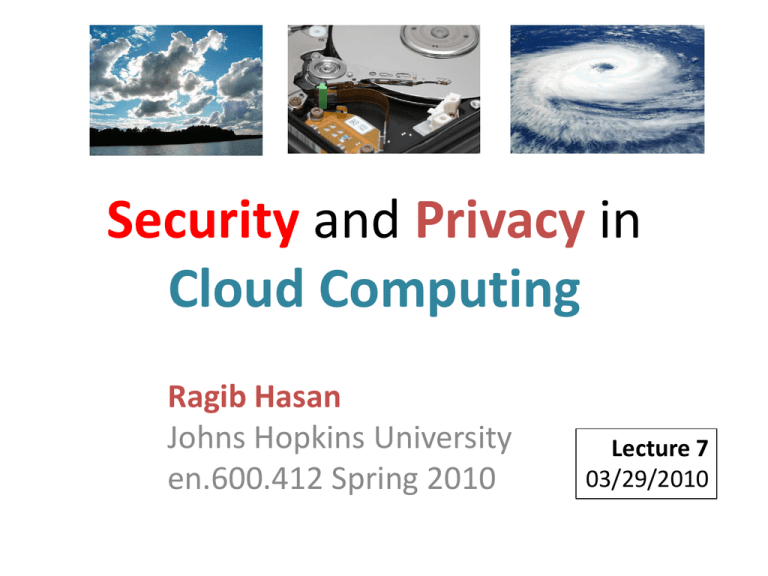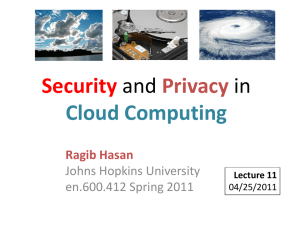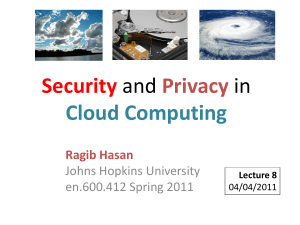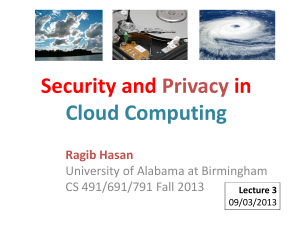pptx - Department of Computer Science
advertisement

Security and Privacy in Cloud Computing Ragib Hasan Johns Hopkins University en.600.412 Spring 2010 Lecture 7 03/29/2010 Provenance • Provenance: from Latin provenire ‘come from’, defined as – “(i) the fact of coming from some particular source or quarter; origin, derivation. – (ii) the history or pedigree of a work of art, manuscript, rare book, etc.; a record of the ultimate derivation and passage of an item through its various owners” (Oxford English Dictionary) • In other words, Who owned it, what was done to it, how was it transferred … • Widely used in arts, archives, and archeology, called the Fundamental Principle of Archival http://moma.org/collection/provenance/items/644.67.html L'artiste et son modèle (1928), at Museum of Modern Art 3/29/2010 en.600.412 Spring 2010 Lecture 7 | JHU | Ragib Hasan 2 • Definition* Data Provenance – Description of the origins of data and the process by which it arrived at the database. [Buneman et al.] – Information describing materials and transformations applied to derive the data. [Lanter] – Metadata recording the process of experiment workflows, annotations, and notes about experiments. [Greenwood] – Information that helps determine the derivation history of a data product, starting from its original sources. [Simmhan et al.] 3/29/2010 et al. A Survey ofen.600.412 Spring 2010 Lecture 7 | JHUSIGMOD | Ragib HasanRecord, 2005. *Simmhan Provenance in E-Science. 3 Forensics and Provenance in Clouds • Cloud provenance can be – Data provenance: Who created, modified, deleted data stored in a cloud (external entities change data) – Process provenance: What happened to data once it was inside the cloud (internal entities change data) • Cloud provenance should give a record of who accessed the data at different times • Auditors should be able to trace an entry (and associated modification) back to the creator 3/29/2010 en.600.412 Spring 2010 Lecture 7 | JHU | Ragib Hasan 4 Privacy questions • Should the cloud provider know the identity of cloud users? • Should cloud users know the identity of other users in the same group? 3/29/2010 en.600.412 Spring 2010 Lecture 7 | JHU | Ragib Hasan 5 The “Bread and Butter” paper Problem – To preserve user privacy and allow anonymous authentication/access in a cloud – To determine authorship of data, i.e., to bind data versions to user identities in a cloud Lu et al., Secure Provenance: The Essential Bread and Butter of Data Forensics in Cloud Computing, AsiaCCS 2010 3/29/2010 en.600.412 Spring 2010 Lecture 7 | JHU | Ragib Hasan 6 Threat Model • Who are the key players? – Users – SM – SP • Who trusts who? – Users: trust the SM, but not the SP – SP: Trust SM – SM: ? • What attacks can happen? 3/29/2010 en.600.412 Spring 2010 Lecture 7 | JHU | Ragib Hasan 7 System Model • SM: Manages the whole system(?), registers cloud users and providers, issues keys • SP: Cloud service provider, manages access to cloud resources • Users: A user is part of a group of authorized principals who can access group resources 3/29/2010 en.600.412 Spring 2010 Lecture 7 | JHU | Ragib Hasan 8 Secure provenance (according to the paper) By secure provenance, the authors imply – Users can anonymously authenticate themselves as part of authorized users/groups to the cloud provider – Users can anonymously access and modify resources – Encrypted data stored by a user can be decrypted by other users from the same group – If necessary, the SM can trace a data item to the user who created it 3/29/2010 en.600.412 Spring 2010 Lecture 7 | JHU | Ragib Hasan 9 Setup Master Key K SM Param (Public Parameters) • Inputs: Security parameter k • Output: Master key, public parameters 3/29/2010 en.600.412 Spring 2010 Lecture 7 | JHU | Ragib Hasan 10 User/provider registration Master Key User identity Ui Private key ski Param (Public Parameters) Tracking list • Inputs: Master key, public parameters, user identity • Outputs: Private key, entry in tracking list 3/29/2010 en.600.412 Spring 2010 Lecture 7 | JHU | Ragib Hasan 11 User-cloud interaction (1) χ σA = signski(Yi||χ) σP / aski User anonymously authenticate herself to the cloud Cloud provider can check that the signature was made with a key issued by the SM 3/29/2010 en.600.412 Spring 2010 Lecture 7 | JHU | Ragib Hasan 12 User-cloud interaction (2) EncryptedData: C = encrypt(M) Sig = signaski(C) Store C and σA Provider stores Signatures and authentication information during each access 3/29/2010 en.600.412 Spring 2010 Lecture 7 | JHU | Ragib Hasan 13 Identifying authorship σA User identity 3/29/2010 en.600.412 Spring 2010 Lecture 7 | JHU | Ragib Hasan 14 Confidentiality preservation • Each user gets a different authorized group user access key • Any group user access key can be used to decrypt a ciphertext created by other users in the same group 3/29/2010 en.600.412 Spring 2010 Lecture 7 | JHU | Ragib Hasan 15 Discussion Suppose Amazon S3 implements such a model. What will be the advantages, and what will be the disadvantages? 3/29/2010 en.600.412 Spring 2010 Lecture 7 | JHU | Ragib Hasan 16 What about other provenance in computation clouds? If the data is being manipulated by processes running in the cloud, how will the problem change? 3/29/2010 en.600.412 Spring 2010 Lecture 7 | JHU | Ragib Hasan 17 Further Reading Ragib Hasan, Radu Sion, and Marianne Winslett, Protecting History Forgery with Secure Provenance, ACM Transactions on Storage, December 2009 3/29/2010 en.600.412 Spring 2010 Lecture 7 | JHU | Ragib Hasan 18








